
Final sewer inspection, North Collector, Montreal, 1955. (Photo source: City of Montreal Archives)
I’m going to go out on a limb here and assume that manhole covers aren’t things that most people pay much attention to. I can’t blame them. I probably wouldn’t give them much thought either, but because they often play an essential role in allowing me to get inside the places I go, I find them a bit difficult to ignore. Even when visiting other cities and have no intention of going underground, I’m still looking at the covers, hoping to catch a glimpse of something unique to the area or to get an idea of where things lead. I can’t help it. It’s a curse.
So on the off-chance that anyone else is interested in these sorts of things, I decided to put together a bit of a guide for the most common ones here in Montreal. And please, no “man hole” jokes. I’ve heard them all before and only eight of them are actually funny.
For a city that often prides itself on being creative and open to the arts, it’s a bit surprising how little effort Montreal has put into the visual design of its manhole covers. If that seems like an odd statement, consider how other cities such as Vancouver, Seattle, New York and Tokyo have commissioned works from various artists for theirs. Not surprisingly, the results are often quite striking. Montreal, on the other hand, seems to have settled for a fairly bland and generic system for marking things. If you’ve never noticed manhole covers here, this is probably the reason why. With that in mind, let’s have a look at what Montreal has to offer.
Sewage
These days, there are two basic types of sewer manhole covers: one set for use out in the middle of the streets and another set for use in pedestrian areas. Both have fairly large square holes which aids proper airflow and ventilation through the system, both are very heavy, and in dire need of some dressing up.
An example of a typical lid found on busy roadways. The fine cross-hatch pattern helps reduce noise levels as cars pass over them. I imagine it must prevent a fair amount of unnecessary tire wear as well. The covers often have “adjustable” or “auto-adjustable” written on them. It refers to how the lid can be raised or lowered to be kept level with the pavement after roadwork occurs. The decorative diamond pattern around the outside edge is about as fancy as they get. Sometimes the wording changes slightly, but that’s about it.
The second type is a bit more nondescript with a square peg pattern. Here’s one with a minimal level of ornamentation and information. You’ll typically find these on sidewalks or grassy areas:
On the other hand, Westmount has some nice designs on older lids that the city hasn’t gotten around to replacing yet. This one’s actually quite common, but many are starting to get worn down from years of traffic:
(For those inclined to look, the full patent information from 1932 can be found here. It seems that even back then, noise from vehicles passing over sewer lids had started to become an issue for locals.)
Elsewhere in Montreal, these capsule shaped sewer covers can still be found here and there. It’s a terrible shape for a lid because it means they have a tendency to accidentally fall down through the hole below which is the last thing you want to have happen:
Water Drainage
Though not technically covering manholes, you’ll find catch basin covers on pretty much every street, parking lot in Montreal. They’re designed to collect and transfer surface runoff into the sewer or stormwater system while keeping out larger objects like trash. If you’ve seen one you’ve seen them all. Really, the only interesting thing I can say about them is that the groves are always positioned in a way that prevents bike tires from getting caught in them.
Electricity
Much of downtown Montreal has its electrical system running underground as opposed to over tr. The lids sitting above the maintenance chambers for this system containing either cables, fuses, transformers or circuit breakers are easy enough to spot. They’re labeled “Montreal Conduits.” They’re fairly large and are most often found alongside sidewalks or in close proximity to buildings. They almost always have the same “woven” design with some minor variations with the placement of ventilation holes.
An older version with Hydro Quebec’s logo in the middle are less common but serve the same purpose:
And of course in Westmount, entirely different designs can still be found from their own electrical distribution company (P&L = Power and Light):
Telecommunications
Similar in size to the electrical conduits, are the maintenance vaults for Bell’s communication services. They’re easily recognized by their hexagon pattern and a Bell logo (either old or new) stamped into the middle. It’s a pretty standard design that can be found in other cities across North America serviced by Bell. You’ll find these either on sidewalks or out in the middle of the street.
Potable Water:
These lids generally sit atop a small chamber that allows for inspection and maintenance of the city’s drinking water system. They’re easy enough to spot from a distance by the square piece that sits in the middle. At first I thought the square part was ornamental, but it turns out it’s purely functional. It can actually be pulled out, which presumably allows workers to open or close a valve without having to remove the lid entirely when water is bursting everywhere. You can find these on just about any street in Montreal as well as in several other communities around the island.
There are also still a few older covers to be found around Montreal that date back to the earlier days of its water distribution system:
The MWPC (Montreal Water & Power Company) helped establish Montreal’s first long-distance network of watermains during the late 1800s. The company was eventually expropriated by the City of Montreal in 1928. This particular one can be found adjacent to the Cartier Monument alongside Parc.
And a later manhole cover installed by the Montreal Water Works who bought out the forcemains which now transfer water to the McTavish reservoir:
Odds and Ends
You’ll find these (or similar-looking) covers where steam or utility tunnel systems are found. There are several like these to be found in the blocks surrounding the garment district of Mile End for a system that no longer seems to be in use:
The ventilation shafts found along Montreal’s metro system will often have one of these enormous lids sitting nearby:
Finally, a pair of these lids associated with the area’s gas lines can be found near the corner of St. Denis and Laurier. I’ve yet to see them anywhere else:
So I guess that just about (ha ha) covers it. Know of any other interesting ones in Montreal or elsewhere? Let’s see them!
Crossposted from www.undermontreal.com


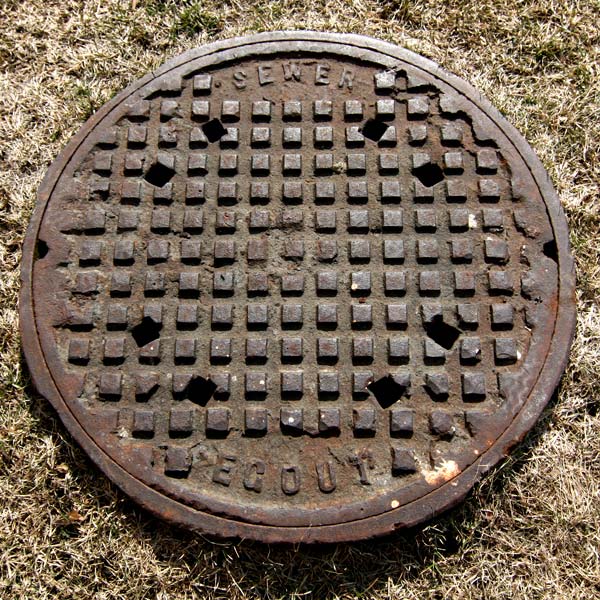
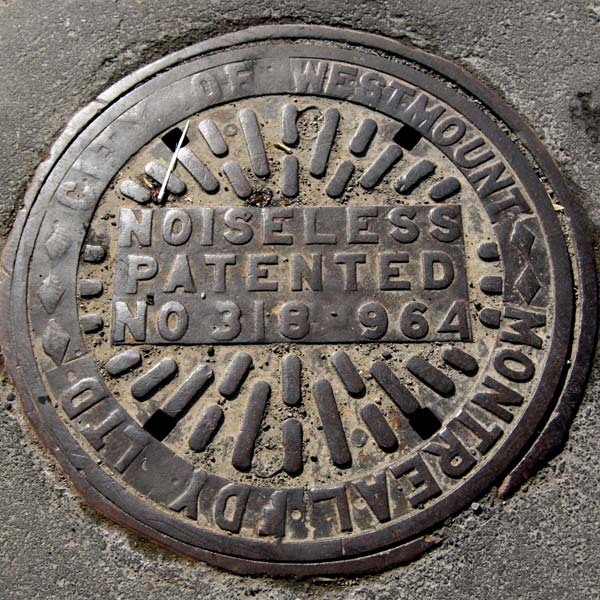
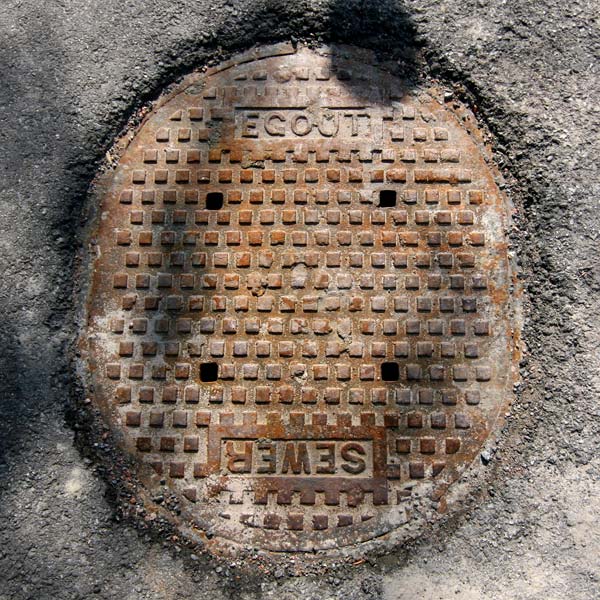
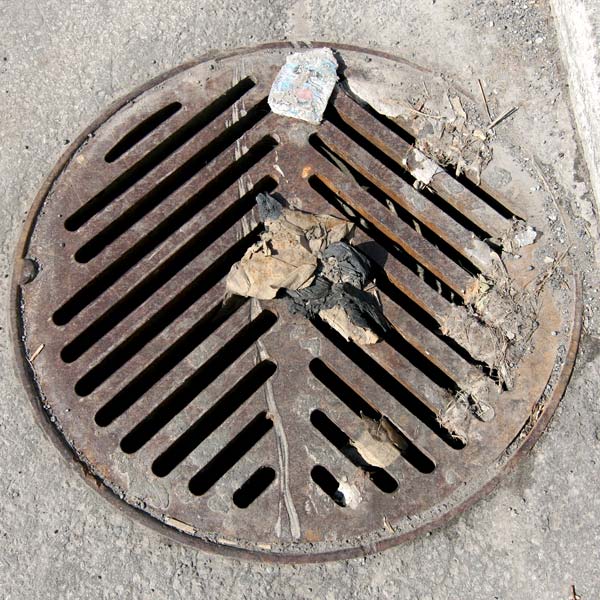
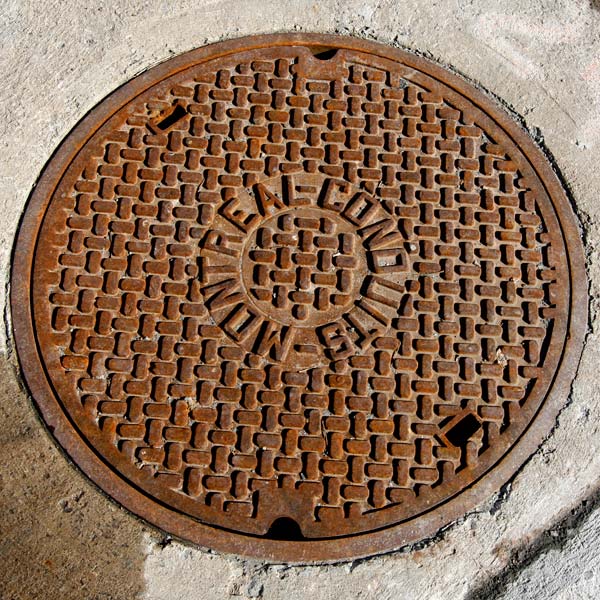
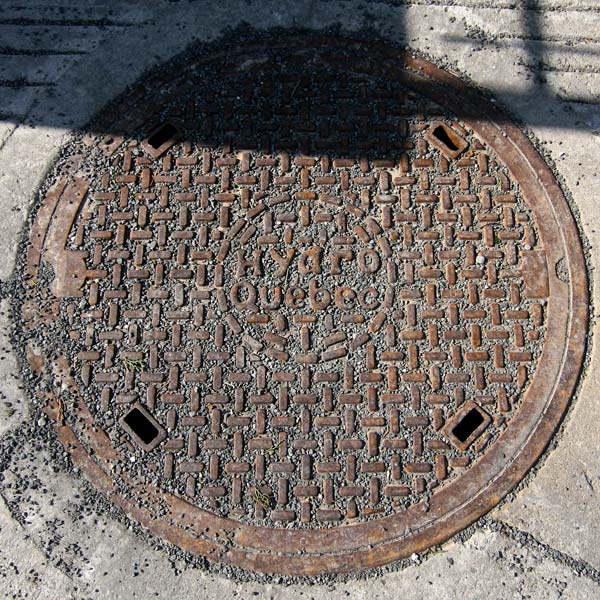
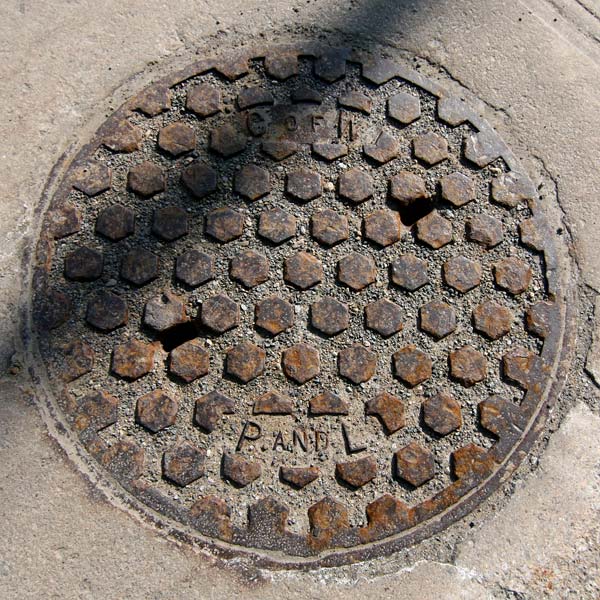
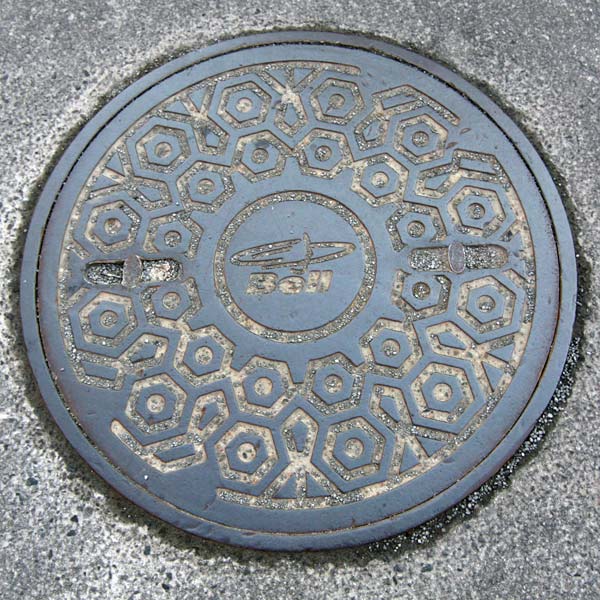
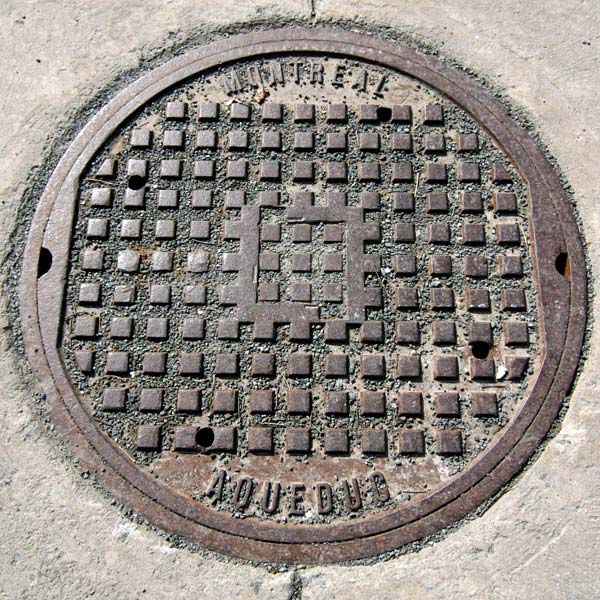

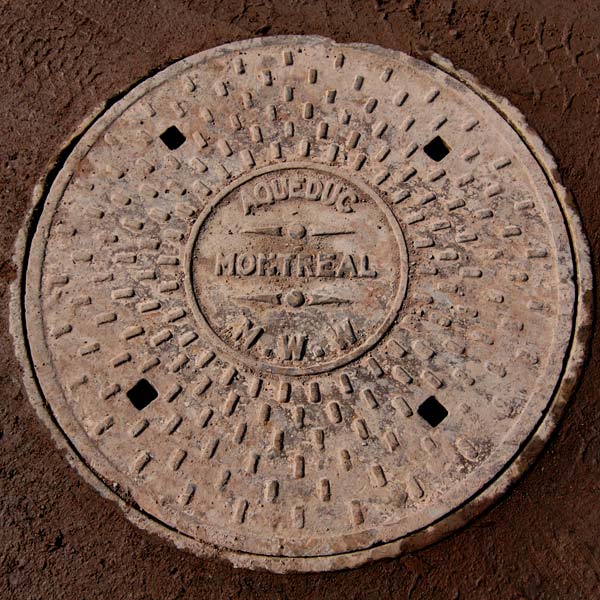
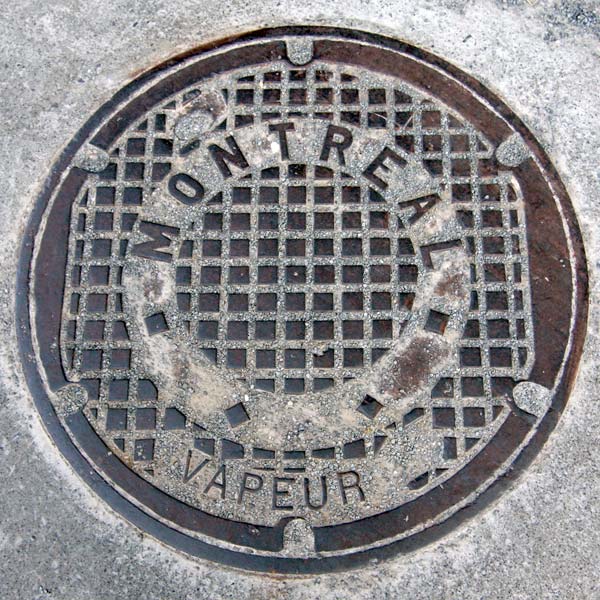
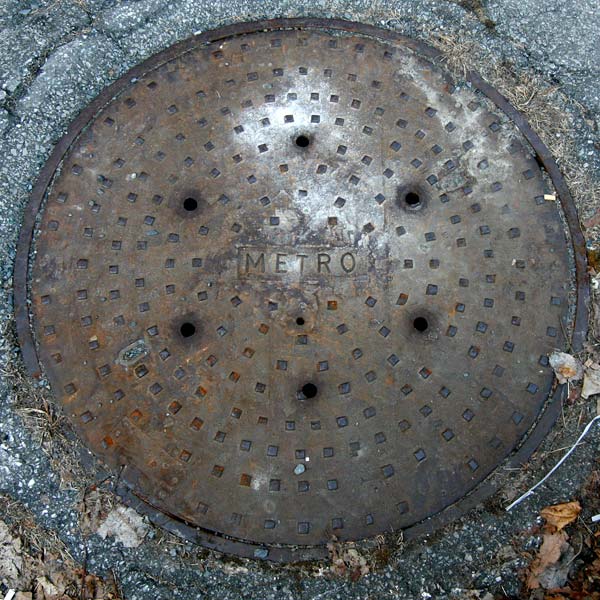
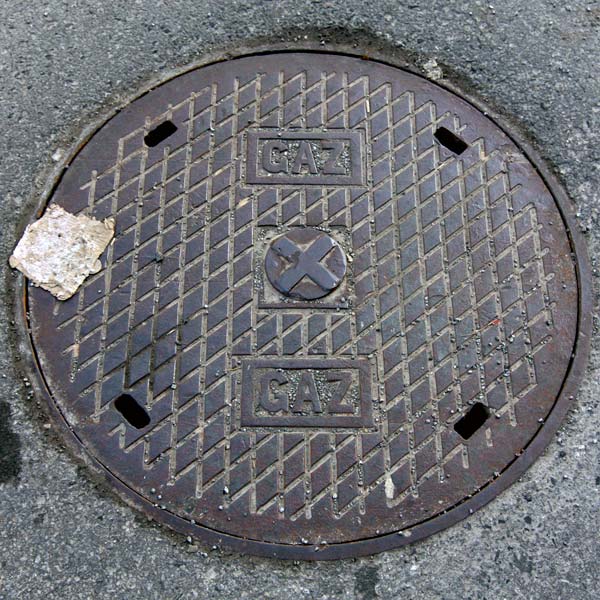
11 comments
Wow. Believe it or not, I actually did want to know all of that about Montreal’s manhole covers. Thanks.
Trop Intéressant.
I remember asking myself some questions, but never really gave it much thought and yet, I couldn’t stop reading your article.
Very well written, thanks for the info.
Interesting indeed! Two notes:
“The fine cross-hatch pattern helps reduce noise levels as cars pass over them”
The cross-hatch pattern on the lid itself is meant to keep cars and people from slipping on them in watery/icy conditions. I’ve walked on a non-patterned lid once or twice and let me tell you, the added traction makes a huge difference. Those unpatterned lids are deathtraps! You can see in the “noiseless” patent that the actual mechanism to prevent noise is meant to do so at the lid-receptacle level.I distinctly remember sewer lids in New York City going CLUNK-CLUNK as cars went over them. This is what it refers to. The CLUNK-CLUNK is cushioned out by means exposed in the patent.
Second note is that those stormwater manholes with diagonal lines as holes were not always there: they used to be straight holes! To boot, those holes used to be so wide that even a mountain bike wheel would get stuck in them! I remember taking more than a tumble about two decades ago as my front bike wheel plunged in to one of those line-holes. Thing is, most of the time they were aligned perpendicularly to the street direction so that wouldn’t happen, but sometimes they would open up the manhole and forget to place the lid back with the desired orientation….. Thank goodness for the diagonal design!
And no, I am not as accident-prone as these comments might lead you to believe! =0)
Cheers!
Glad to see I am not the only one who looks at Man Holes covers! They are not far removed, and in fact are sometimes located very near to sidewalk plates installed by the contractors when the sidewalks were poured.
Glad to see that there are still some of the ‘Capsule’ type still around, as I never saw one on my last sojurn to Montreal in Oct. 2008.
As I recall, Canadian Pacific Telegraphs had their own conduits and covers fifty-odd years ago, and, I will once again go out on a limb and say possibly that Montreal Tramways had covers at one time for conduits carrying their traction feeders at cable vaults and near their substations??
Dominion Electric Protection, now ADT, once had their own cables, conduits and such hardware for their lines which provided Fire, Sprinkler and Intrusion alarm/supervisory services. I suspect they had their own covers, too.
Catch basins have completely evolved. One style that came into vogue in late sixties was an in-sidewak version which had it’s own cast ‘Man Hole’ cover set in concrete with the water opening crossed with a bar in curb.
This version replaced the sheet metal cover style with hooks which sat flush on top, which, once got bent, would be peeled off by a sidewalk plow and get taken for a ride.
This, obviously, left a gaping hole for the next pedestrian to fall into.
If not found, the lid would go into a Snow Blower with a satisfying grind and LOTS of sparks and a certain amount of danger.
Also were the smaller valve holes and their MWW covers, two square hole, which sleeved into an approximately 1 foot pipe and were so that under-pavement water valves could be open or closed by City crews using a long Tee-handled rod.
These could also be found in the street at hydrants so the feeder to the hydrant could be closed when valve leaking at hydrant base, and where water shut off valves set in sidewalk.
The distance in feet was stencilled on hydrant facing this valve so city crews could locate same under dirt or snow.
These MWW covers could make a very annoying high-pitched echoing Clonk when driven over, even on a bicycle, there being one on Fielding that I ran over every time on the junker 28 1/2 inch CCM bike I had, just to annoy the appartment dwellers facing Cornation Park.
Lovely work that brought back even more memories!
Thank You!
P.S. Once in older districts, the curved sidewalk curb at intersections would be FACED with a sheet steel strip about 12 inches high and maybe 25 feet long. I assume this was to prevent abraiding of tires on vehicles rubbing curb when cutting tight to avoid other traffic or a streetcar on old tight, narrow streets.
Once, curb stones were Granite and in various colours, with grass in between. Looked quite nice.
I did not think there could even be eight ‘Man Hole’ jokes, Amazing!
there’s a new modern-style manhole cover design not in your photos. There are some around Parc St-Joseph NW corner.
Fray: the traction aspect you mentioned makes sense. As for the catch basin lids, you’ll see the type you described. Hopefully they always remember to position them the right way.
Cdnlococo: Great details. Thanks!
Bob: Thanks, I’ll have to look for those the next time I’m up that way. There are quite a few different ones along the north shore, but I decided to keep things to the downtown area for this post.
Great article with lots of fascinating details! Here in Toronto we have a similar mix with a fair number of dated street drain covers – particularly in the older areas of the city – all dated 1889. (Did the City install thousands that year or did they just keep using the old molds for decades?). Toronto also has ‘handwells’ set into many sidewalks to allow access to the wiring for street lighting – these were recently malfunctioning and Toronto Hydro had a massive inspection effort – inspected handwell covers were painted red so here we also have, at least for a few weeks, flashes of sidewalk colour!
Great post– it reminds me of a multimedia presentation in the NY times on where the New York man hole covers are made:
http://www.nytimes.com/2007/11/26/nyregion/26manhole.html?_r=1&scp=1&sq=man%20hole%20covers%20new%20york&st=cse
Any word on where Montreal’s come from?
David: I was just in Toronto recently and was kind of jealous about the dates on the lids. The only dates I’ve seen here are on the little lids connected to curbside gutters- and most of them are from the 1990s. Stuff like that definitely helps take the guesswork out of things, but like you said, they might have just re-used the same mold.
KC: I’ve seen the name Laperle on a few of the newer covers and their Foundry is out in St. Ours. No idea where the bulk of them come from, though. Maybe somewhere overseas at this point. I wish I knew.
Thank You once again for another great article on the man made subterranean waterways beneath the city of Montreal!
When the citizens pay taxes, they really do not know how much of the tax dollar is spent on high-cost projects such as underground piping which safely conduct away sewage and runoff from our homes and thoroughfares.
Not to mention the cost of installation of mains for potable water and for natural gas.
Also hidden away are the conduits for telephone, hydro power and other services.
Before fibre optic conductors and cell telephones were developed a great deal of telephonic data was transmitted by copper wire cable with 2700 pair cables being common, one pair usually reserved for one telephone number.
Knowing the amount of telephone numbers can give an estimate of how many pairs are required for one-party service in an area = the size of cables required and how many conduits for them.
Here is a photo from the last day of streetcar operation on Ste Catherine in 1956. Car on Route 3 is Westbound to Elmhurst Terminus on Sherbrooke St. West at CPR Montreal West Station.
Ste Catherine was bi-directional into the Sixties.
What is interesting to the topic of underground services is that to the right of the photo on the trolley wire support pole beyond the Dodge automobile is a Conduit containing a trolley wire feeder up to the two parallel trolley wires above the tracks being supplied with electricity from another underground feeder in a Conduit.
http://www.stm.info/en-bref/tramways/images/S61112/S611123_28.jpg
The Traction Cables of the era were lead-sheathed, and on the pole in question, protected from abrasion or collision by a steel pipe up 12 feet or so.
Nearer the top of the pole is a box containing a fuse and a switch, which would isolate the trolley wires East and West of this feeder location in the event the wires were fouled by a tall truck, brought down by ice, or had to be de-energized for repair or in the event of a fire next to the tracks.
The feeders ran in their own Conduits adjacent to the street upon which the streetcars operated.
As you mentioned, where there are conduits and cables, there are cable vaults, the latter usually capped with a monogrammed Man Hole cover of the utility beneath.
It would be nice to locate a man hole cover marked Tramways, but, its been fifty years since streetcars were removed in 1959.
Possibly there could be ex Tramways conduits in the North end where the trolley busses operated thru 1966?
Thank You Again for bringing to light what is so well hidden beneath the city. Your visuals are unique!
wow , these are great picks. great variety of manohle covers